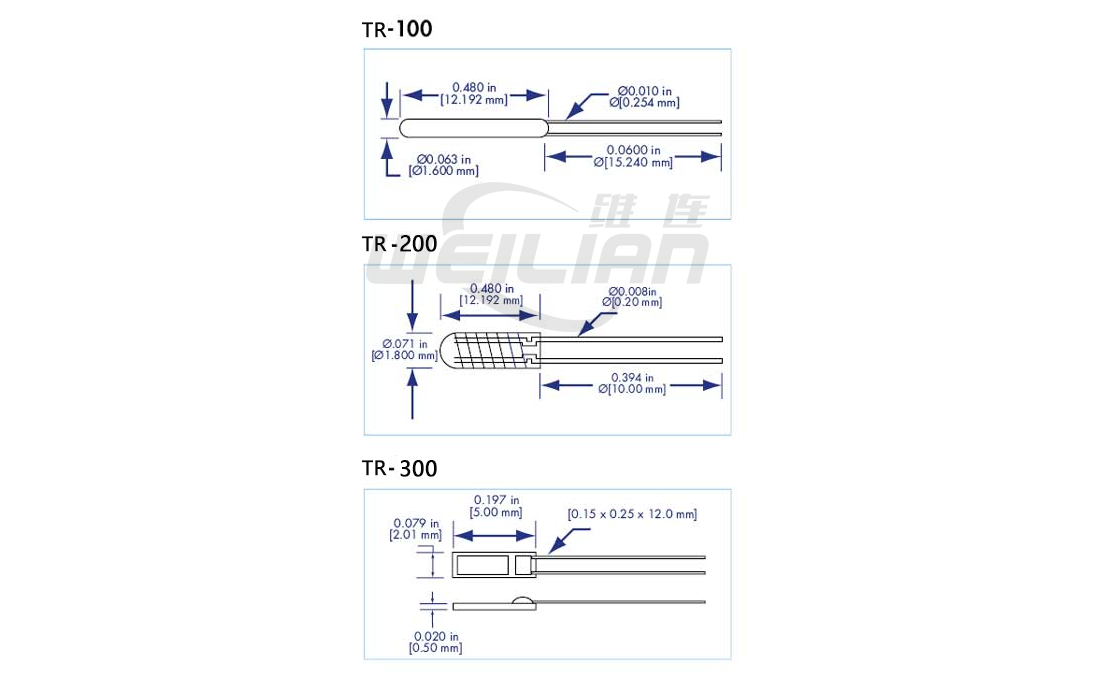
Which low -temperature temperature sensor is the low -temperature experiment
Correct Choosing Low temperature temperature sensors may be difficult, especially for the first low -temperature experiment. However, different sensor types have certain general characteristics and can be used to choose the correct sensor.

The Silicon diode of the TR950 series is a better choice for general low temperature applications between 1.4 k and 400 K. All sensors are replaced (they follow the standard curve) and provide various settings of solid kit (see Figure 1). The design is simple and cost -effective. They are used for extensive low -temperature applications, such as low -temperature coolers, laboratory low -temperature, low -temperature gas production and space satellites. Platinum RTD ( resistor temperature detector ) is an industrial standard. The National Standard and Technical Research Institute (NIST) also use it within the range of 14 K to 1235 K. They follow the industrial standard curve up to 30 K, and have good sensitivity in the entire bandwidth. At a lower temperature, you need to calibrate RTD alone. Because of their excellent reproduction, they are used for many precision measurements.

Platinum RTD has a limited design, cost -effective, and only needs simple instruments. They are widely used in the application of liquid nitrogen or higher temperature.
The oxidation d RTD can be used for 50 MK and below. Their advantages are low magnetic resistance and standard curve. Their temperature limit is 40 K (low -temperature sensor performed better in a magnetic field exceeding 2 K). The oxidation RTD is used to apply the standard curve of the magnetic field, such as the MRI system. Except for 锗, they are the only low -temperature temperature sensors that can be used below 100 MK. Gaalas diode provides high sensitivity within a wide range (1.4 k to 500 k). They are very suitable for medium magnetic fields and have many advantages of silicon diode. However, because they do not follow any standard curve, the silicon diode is usually preferred, except for the middle magnetic field application. Choose a low -temperature sensor for the latter because they can be used within the range of 100 MK to 420 K, and they have high sensitivity throughout the temperature range. With low magnetic resistance, it is the first choice for the application of the magnetic field as high as 30 T (temperature higher than 2 k). In addition, low -temperature sensors can resist ionizing radiation. Other sensors are thermal components and capacitor sensors. However, they are not accurate, so they are not suitable for low temperature experiments. Thermal components follow the standard curve and can be used for harsh environments within the wide range of spectrum. Capacitor sensors are very suitable as controlled sensors in a strong magnetic field because they have almost no magnetic field dependence. With low magnetic resistance, it is the first choice for the application of the magnetic field as high as 30 T (temperature higher than 2 k). In addition, low -temperature sensors can resist ionizing radiation. Other sensors are thermal components and capacitor sensors. However, they are not accurate, so they are not suitable for low temperature experiments. Thermal components follow the standard curve and can be used for harsh environments within the wide range of spectrum. Capacitor sensors are very suitable as controlled sensors in a strong magnetic field because they have almost no magnetic field dependence. With low magnetic resistance, it is the first choice for the application of the magnetic field as high as 30 T (temperature higher than 2 k). In addition, low -temperature sensors can resist ionizing radiation. Other sensors are thermal components and capacitor sensors. However, they are not accurate, so they are not suitable for low temperature experiments. Thermal components follow the standard curve and can be used for harsh environments within the wide range of spectrum. Capacitor sensors are very suitable as controlled sensors in a strong magnetic field because they have almost no magnetic field dependence. Thermal components follow the standard curve and can be used for harsh environments within the wide range of spectrum. Capacitor sensors are very suitable as controlled sensors in a strong magnetic field because they have almost no magnetic field dependence. Thermal components follow the standard curve and can be used for harsh environments within the wide range of spectrum. Capacitor sensors are very suitable as controlled sensors in a strong magnetic field because they have almost no magnetic field dependence.
During the heat cycle, the capacitance and temperature curve will change slightly. We recommend using other low -temperature temperature sensors to measure the temperature in zero field and use the capacitor sensor as the control unit.

